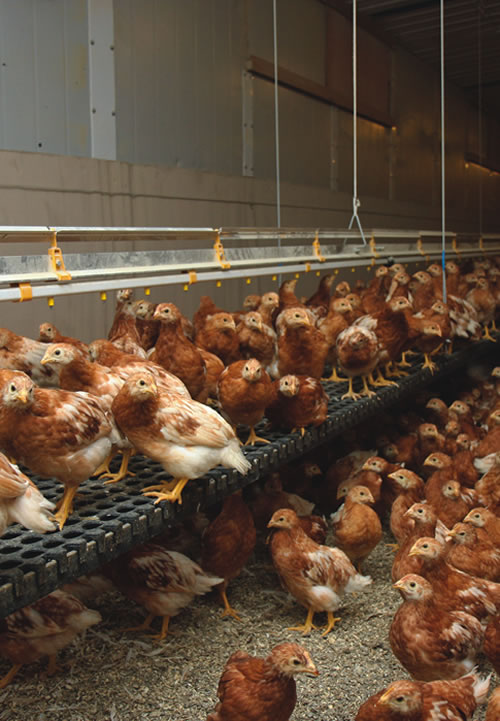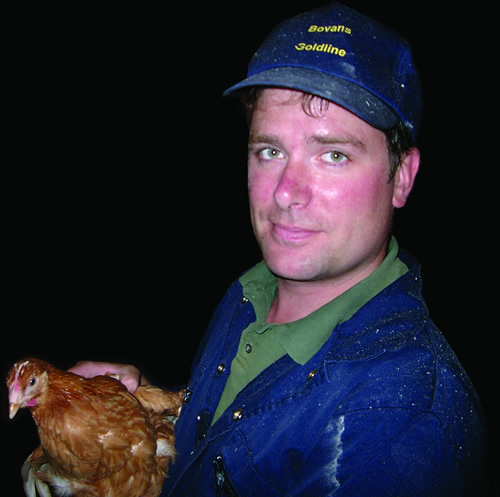
"Correctly reared, healthy pullets are essential prerequisites for successful egg production in alternative systems. Underweight, uneven pullets for example will be less able to adapt to life in the laying house, and will be more susceptible to stress leading to other welfare problems. It is important therefore that the specification for the pullets is agreed with the rearer at the time the birds are ordered. It is also good practice for the stock keeper to inspect the pullets at least once before delivery to check that all is well."
The above advice is given by DEFRA in its leaflet entitled ’The Welfare of Hens in Free Range Systems’. It’s unlikely that Free Range producers would disagree with any of these points. But is there anything you can do to make sure that your pullets are healthy? What steps can you take if you have concerns? How many producers follow the ’good practice’ outlined above, and go to inspect their future flock at the rearing farm before delivery. And is there universal agreement within the industry that these recommendations constitute best practice?
VISITING THE REARING FARM
BFREPA Chairman Tom Vesey does visit his pullets – but he knows that not all BFREPA members do. "As producers, we have got to start taking more interest in our pullets whilst they are in rear," he says. "I visit my pullets at week 5, week 10 and week 12. My rearer has never objected. In fact he seems glad to see me taking an interest."
Pullet rearers do not all share this view, however. Doug Kirkby, of Tom Barron ISA, points out that rearing farms must, in the best interests of their customers, exercise the strictest biosecurity – and this means treating every visitor as a potential health hazard. Another pullet rearer commented that he was not in favour of producers coming to visit because of the danger of introducing contamination from their own farms into his rearing sheds. "We have a good relationship with our clients and we will send them an update by fax or email whenever they want. This gives them all the information they need without the biosecurity risks," he stated. Nick Bailey, of Joice and Hill, recognises that biosecurity concerns may justifiably lead rearers to discourage visiting too early in rear – but he does feel there are several good reasons for producers seeing their pullets towards the end of rear.

WHAT TO LOOK FOR
Bodyweight is good indicator of a healthy pullet, and indeed of a healthy chick: "We can tell a good chick by its bodyweight at day old and in the first few weeks," Steve Carlyle of Country Fresh Pullets confirms. Tom Vesey says his prime concern is to be sure that his pullets are consistently up to the specified weight throughout rear. He explains: "The fact that a pullet is the correct weight when it arrives at your farm is not in itself any guarantee. Bodyweight has to be laid on right from the start so that the bird’s skeleton develops. If weight gain is slow at first and then picks up late in rear, the bird is likely to have a higher proportion of fat and insufficient skeleton. At each visit I see my pullets being weighed, and I compare the result to the target weight."
"Generally speaking, a good bodyweight at transfer is advantageous," says Nick Bailey, "but uniformity is important too. Weigh 60 birds, and 75% should be 10% of the average weight." Doug Kirkby and Steve Carlyle likewise stressed that uniformity of weight is very important. David Scott, of Lohmann GB, agreed that evenness was the main aspect to look for and added: "In addition, it is natural for birds to lose some weight in transfer from the rearing farm to the laying farm. It is essential for producers to concentrate on getting the birds drinking well and eating as soon as possible." Doug Kirkby also made the point that whilst bodyweight is a good yardstick, even if birds are slightly underweight at the time of delivery this does not necessarily indicate a problem provided they continue to put weight on.
Finally, Nick Bailey suggested a couple of other things that producers may wish to check if visiting the rearing farm: that ventilation is adequate and the air quality is good, and if producers have firm views on rations they might want to enquire about this too. "Pullets may be fed crumbs in the early weeks to promote weight gain, but my personal view is that this should not be continued beyond five or six weeks. After that I would want my birds to be fed only mash."
SPECIAL REQUIREMENTS
Rearers always do their best to meet the producer’s requirements, but Nick Bailey points out that the onus is initially on the producer to tell the rearer what those requirements are. Over time, as a relationship builds up between producer and rearer, the rearer will not need to be reminded; but new producers should explain any special requirements when they place their order. It must be borne in mind, though, that it is simply not always possible to be too prescriptive, especially in the case of small orders. "If you have only ordered 4,000 pullets, you cannot dictate conditions for the whole of the rearing shed," John Widdowson says. "You have to be a bit flexible."
Nick adds that in his experience many producers do not order their pullets early enough. He advises placing orders at least nine months in advance. He explains: "Pullets are four months in rear, and you have to add at least another month to allow for order processing and incubation. But by giving more advance notice, a producer will increase the likelihood of getting all the facilities he requires." Doug Kirkby echoes this: "Order sizes and rearing shed capacities tend not to match," he points out. "Producers should give plenty advance notice to make sure the appropriate rearing space is allocated to their order." John Widdowson’s policy is to place his next order as soon as a new flock has been housed, so that in effect he is giving 58 weeks’ notice.
VACCINATION AND BLOOD SAMPLES
Concerns are sometimes expressed over the increasing number of vaccinations that pullets are subjected to. This issue is not specific to the UK, as we understand that other countries are also looking carefully at their vaccination programmes. The dilemma is that producers naturally want to make sure that their flock is fully protected, but as Steve Carlyle points out, every time a pullet is vaccinated this will have an effect on bodyweight; and in some cases up to 20 vaccinations are specified during rear. David Scott added: "We see this when comparing Lohmann flocks in the UK with Lohmann flocks in countries with very mild vaccination programmes, like Sweden. Genetically the birds are exactly the same but birds in Sweden will be typically 80g heavier as they only receive two vaccinations throughout the rear". However, Nick Bailey does not feel that our pullets are currently suffering from being over-vaccinated. "In an ideal world, each flock would only be vaccinated against the bugs that are likely to be present on the farm where it will be kept," he says. "But it is often not practical to implement an individual vaccination programme for each flock, since different flocks are likely be in close proximity at the rearing farm. A comprehensive vaccination programme is therefore necessary to provide full protection. This should not cause any problems provided that sufficient space is allowed between vaccinations, and the birds are in good health when they are vaccinated."
The majority of rearers have a policy of taking a blood sample, usually at 11 or 12 weeks, to check the presence of the live vaccines in the pullet; this will confirm that the vaccinations have worked. Nick Bailey advises producers to check with their pullet rearer whether or not this is don
